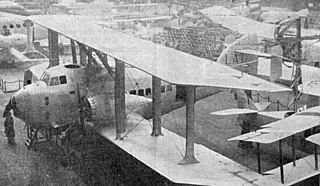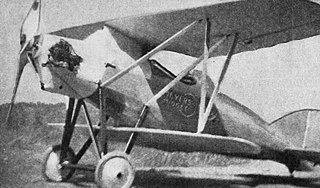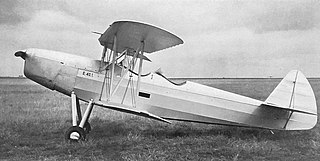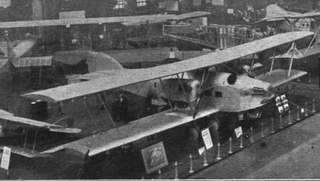
The Aero A.23 was a Czechoslovakian airliner of the 1920s. Aero Vodochody had produced the first Czech airliner, the A.10, four of which had served with ČSA, the national airline. The A.23, another biplane, was bigger, more powerful and could carry more passengers.

The Vickers Type 161 was an unusual 1930s pusher biplane interceptor, designed to attack aircraft from below with a single upward-angle large calibre gun. The aircraft flew well but the concept was abandoned and only one was built.

The de Schelde Scheldemusch was a single-seat pusher biplane designed in the Netherlands to be easy and safe to fly. It was one of the first light aircraft to use a tricycle undercarriage. Despite a sales campaign in the UK, only six were built, one being briefly tested by the RAF. A single example of a flying boat version, one of the smallest of this class, was also built.

The Latécoère 4 was a three-engined, 15-passenger biplane built in France in the early 1920s. It proved difficult to fly and was discontinued, though a second machine was completed as the Latécoère 5 bomber.

The Cranwell CLA.2 was a single-engined two-seat biplane built by staff and students of RAF College Cranwell as an entrant to the Lympne Two Seater Light Aeroplane Trials of 1924. It won the reliability prize.

The Meyers Midget was a one-off small, low-powered, sporting single-seat sesquiplane, designed and built in the United States in 1926, incorporating several innovative structural features.

The SAB-SEMA 10 was a single-engine advanced trainer, designed and built in France as the SEMA 10, in the 1930s. It failed to win a French production contract and only one was built. Re-engined, modified and redesignated SAB-SEMA 12, it served with the Spanish Republican Air Force at the beginning of the Spanish Civil War.

The Praga E-40 was a single engine, two seat, biplane basic trainer, built in Czechoslovakia in the mid-1930s.

The Potez XVIII was a French airliner from the early 1920s, a three-engine biplane carrying up to twelve passengers.

The Caudron C.33 "Landaulet Monsieur-Madame" was a French twin engined biplane with four seats, two in open cockpits and two in an enclosed cabin.
The Caudron Type C was a single seat French biplane, intended for military evaluation. Two were built in 1911.

The Caudron Type D was a French pre-World War I single seat, twin-boom tractor biplane, a close but slightly smaller relative of the two seat Caudron Type C. More than a dozen were completed, one exported to the United Kingdom, where they may also have been licence built, and three to China.

The Heinkel HD 20 was a twin engine, three seat German biplane built in 1926 for civil survey work.

The Dewoitine D.430 was a three-engine, high-wing monoplane designed for policing and other roles in France's colonies. It did not go into production.
The Weymann W-100, Weymann CTW-100 or Weymann W-100 RBL was a French three seat observation aircraft with a position for the observer within its partially glazed fuselage. Only one was built.

The Weymann-Lepère WEL-80 R.2 was a French two seat reconnaissance aircraft built to compete for a 1928 government contract. It was not successful and did not enter production.
The Caproni Ca.66 was an Italian night bomber designed to reequip the post-World War I Italian Air Force. Only two examples of the four-engined biplane were built.

The Raab-Katzenstein RK.9 Grasmücke (Hedge-sparrow) was a 1920s German two-seat touring, advertising and training biplane. It was one of many designs from several countries aiming to provide low cost flying and was quite successful, with about twenty built.

The Medwecki and Nowakowski M.N.5 was an economical Polish trainer aircraft initially aimed at the club market, though there was also some military interest. It performed well but lacked a constructor after Samolot became insolvent in 1930, so only one was completed.
The Tokyo Koku Aiba 11 was a 1940s Japanese civil transport aircraft derived from the Tokyo Koku Aiba 10 trainer. Its cabin accommodated three passengers on taxi or sight-seeing flights. Though well-regarded, developing military demands prevented its production.















